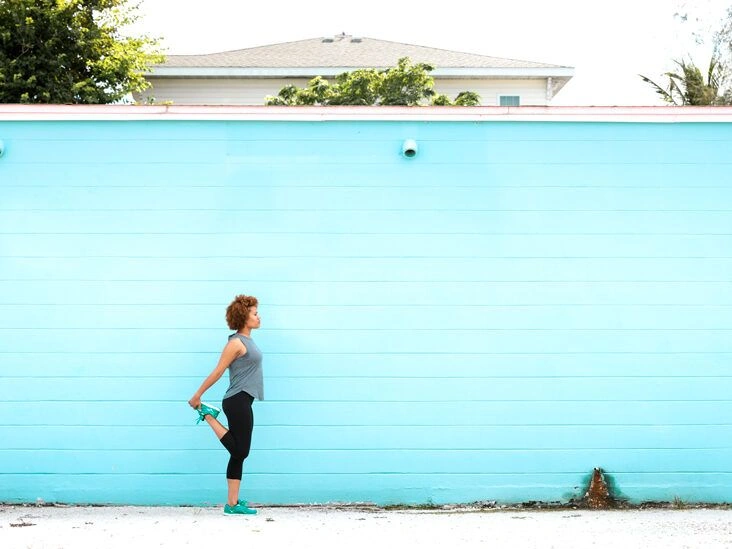Sports that involve a lot of running and jumping frequently lead to jumper’s knee, a condition that produces pain around the kneecap. Targeted lower-body movements can reduce discomfort, increase strength, and lower the chance of recurrence.
Jumper’s knee — often called patellar tendonitis or patellar tendinopathy — weakens the patellar tendon that links the kneecap to the shinbone, producing varying levels of pain, swelling, and stiffness.
It most commonly develops from repetitive strain in athletes involved in jumping or running disciplines like skiing, basketball, and volleyball.
The exercises below for jumper’s knee are designed to boost strength, flexibility, and joint mobility. Start with the simplest, least painful moves and gradually progress to more demanding routines.
Pay attention to your body and skip exercises that provoke significant pain. Mild soreness after sessions can be normal, but overall pain should improve day by day.
Allow rest between sets and long-held positions when needed. For movements that involve both legs, begin with the injured side.
Standing hamstring stretch
To protect your lower back, keep a straight spine and draw your shoulders back while hinging from the hips.
- Place the heel of one foot on a step or stool roughly 15 inches (38 cm) high.
- Keep the leg straight and slowly bend forward from the hips until you sense a gentle stretch along the back of the thigh.
- Hold for up to 30 seconds.
- Repeat three times.
- Then switch to the other leg.
Standing quadriceps stretch

Keep good posture by lengthening your spine and maintaining a neutral lower back.
- Stand next to a wall or chair for balance.
- Place one hand on the wall or the back of the chair for support.
- Reach back with your other hand to grasp your ankle.
- Gently pull your heel toward your buttock.
- Hold the stretch for 15–30 seconds.
- Repeat 2–3 times.
- Then perform the stretch on the opposite leg.
Side-lying leg lift

Keep the top leg mostly straight with only a slight bend at the knee.
- Lie on your side.
- Activate the front thigh muscles of the top leg.
- Slowly lift the leg about 8–10 inches (20–25 cm).
- Lower it back to the starting position with control.
- Complete 2 sets of 15 repetitions.
- Then repeat on the other side.
Seated quad set

Sit on the edge of a cushion to help keep your hips aligned and maintain an upright spine.
- Sit on the floor and extend the injured leg straight out in front of you.
- Bend the other knee toward your chest.
- Lift the heel of the injured leg while pressing the kneecap gently down toward the floor.
- Hold for 10–20 seconds.
- Repeat 10–15 times.
- Then work the opposite leg.
Bug squash

Maintain a neutral spine and keep your hips level to prevent compensations and excess strain.
- Lie on your back with both knees bent and your toes resting against a wall.
- Raise the injured leg and place the sole of your foot flat on the wall.
- Press the foot into the wall, contracting your thigh muscles.
- Hold this position up to 45 seconds.
- Repeat five times.
- Then perform the same on the other side.
Benefits of home-based exercises for jumper’s knee and prognosis
Doing exercises at home for jumper’s knee offers several advantages for recovery and overall prognosis. They can restore flexibility, mobility, and muscular strength while diminishing pain and swelling.
Although you might feel some stiffness and mild discomfort initially, your joint mobility should gradually return to its prior level.
Check with a healthcare provider before resuming sports. In most cases, you can return to your previous activities once you’ve recuperated.
The recovery timeline ranges from a few weeks to multiple months, depending on the severity and individual factors like general health.
Frequently asked questions
Can jumper’s knee fully resolve?
With time and appropriate care, jumper’s knee can resolve completely. Recovery time varies by severity and may take several weeks to months.
Rest is a key component, along with home strategies such as icing, using a supportive brace, and taking anti-inflammatory medications if advised. Strengthening routines help restore function and lower the risk of re-injury.
What speeds up recovery from jumper’s knee?
To accelerate healing, prioritize rest and avoid high-impact activities that stress the tendon.
Apply ice for 15–20 minutes multiple times daily to reduce pain and inflammation. Work with a physical therapist to learn strengthening and conditioning exercises that protect the knee.
Which exercises should be avoided with jumper’s knee?
Avoid movements that place excessive load on the knee and exacerbate symptoms, such as deep squats and lunges.
Also steer clear of running and high-impact sports that involve frequent jumping and sudden changes in direction, including soccer, basketball, and volleyball.
How can you prevent jumper’s knee from coming back?
To reduce recurrence risk, return to sports gradually and avoid pushing through pain. Stop activities that provoke symptoms.
Even after recovery, continue with stretching and strengthening routines for the knee.
Consider guidance from a physical therapist or qualified trainer to ensure correct technique and identify the most useful exercises for your needs.
Maintaining a healthy weight and wearing well-cushioned, supportive footwear can also help. A knee brace is another option to consider.
The bottom line
Jumper’s knee is common in athletes who take part in vigorous sports with lots of running and jumping.
Rest and targeted home exercises play a central role in recovery. You can often remain active with low-impact options like swimming, cycling, or using an elliptical, provided they don’t cause pain.
With suitable treatment and management, most people recover fully and can resume their normal activities.


















Leave a Reply
You must be logged in to post a comment.